| |
|
Saturday, May 17 Tifereth Israel Synagogue—Dizengoff Night


Sunday, May 18 Community Israel Independence Celebration

Wednesday, May 28 JFS~Ellen Saks lecture on mental illness
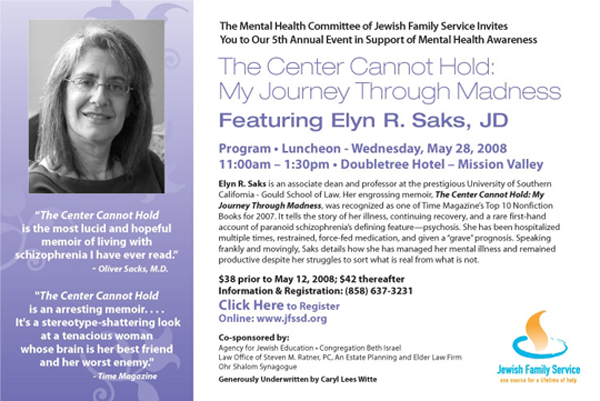

Tuesday, June 3 Guardians Golf & Tennis Tournament


Friday-Saturday, June 6-7 JFS~Judaism on the Wild Side

Sunday, June 8 Temple Solel~Tikkun Leil Shavuot


LETTER FROM JERUSALEM
Intolerable situation on the Gaza border
By Ira Sharkansky
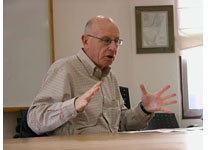 JERUSALEM—On Monday a grandmother was killed on one of the kibbutzim near Gaza by a Palestinian missile. Saturday a member of another kibbutz died in the same way. Saturday's victim was a professional photographer. We saw a film of him expressing his willingness to live alongside Israel's borders. JERUSALEM—On Monday a grandmother was killed on one of the kibbutzim near Gaza by a Palestinian missile. Saturday a member of another kibbutz died in the same way. Saturday's victim was a professional photographer. We saw a film of him expressing his willingness to live alongside Israel's borders.
When is enough enough?
Israel's government seems to be dithering with Hamas and other armed groups, via Egyptian intermediaries, about a cease-fire. Israel would like to link the cease fire with the release of Gilad Shalit, held prisoner in Gaza by one of the groups, for almost two years. Palestinian groups are saying that they may re-open talks about his release if Israel agrees to a cease-fire. Israel also wants an end to the flow of armaments to Gaza through Egypt. There seems little chance that another agreement on this issue will be more successful than previous agreements on the same issue.
Israel's government is risking its self-respect. It has the capacity to make the people of Gaza pay a heavy price for the continued shelling of settlements in Israel, but it refuses to use that capacity.
One member of a kibbutz subject to bombardment, when interviewed on radio, called for an artillery barrage on Gaza in response to every missile sent toward Israel. It would not be necessary to risk Israeli soldiers.
The kibbutz member termed himself a leftist. That usually means, "peace loving."
Would this kibbutz leftist remain on message when Gazans start dying in the hundreds or thousands? Israeli artillery is more deadly than the rockets of Gaza.
 Another member of a kibbutz near Gaza ridiculed the proposal of adding shelters to homes and public buildings. That would legitimize the continuation of rocket attacks. Another member of a kibbutz near Gaza ridiculed the proposal of adding shelters to homes and public buildings. That would legitimize the continuation of rocket attacks.
Why not a more forceful response?
It would risk the peace process. The people in nominal charge of the West Bank could not continue peace discussions if Palestinians were dying in Gaza. The White House could not accept this. President Bush continues to say that Mahmoud Abbas is a credible partner for peace.
Europeans would respond badly. They might impose economic sanctions on Israel. Jimmy Carter would say again that Israel is committing war crimes in Gaza worse than the apartheid it is practicing in the West Bank. Not a few American Jews would join some Israelis by expressing their shame about a country that uses weapons rather than agreements in order to attain peace.
Can we count on Israel's prime minister to act heroically? The police investigation may be weighing on him, and it can take a while to reach any conclusion. "A while" in the Israeli context means several months at the least.
Olmert was photographed yesterday nodding off to sleep while attending a meeting. He woke up to say that the subject of the meeting was close to his heart.
I have yet to hear an Israeli commentator indicate that Abbas is strong enough, or willing enough, to reach an agreement that Israel is likely to offer, and to impose an end to violence on his population.
A snippet from Atlantic does not encourage us to rely on Barak Obama.
Do you think that Israel is a drag on America’s reputation overseas?
No, no, no. But what I think is that this constant wound, that this constant sore, does infect all of our foreign policy. The lack of a resolution to this problem provides an excuse for anti-American militant jihadists to engage in inexcusable actions, and so we have a national-security interest in solving this, and I also believe that Israel has a security interest in solving this because I believe that the status quo is unsustainable. I am absolutely convinced of that, and some of the tensions that might arise between me and some of the more hawkish elements in the Jewish community in the United States might stem from the fact that I’m not going to blindly adhere to whatever the most hawkish position is just because that’s the safest ground politically.
Clinton's candidacy is not promising. Moreover, her comment about destroying Iran is not something anyone can rely upon.
Can we hope that McCain does not have a senior moment in front of the cameras before November?
It is time to calculate Israel's responsibility to defend its population, against the possibilities of embarrassing whoever is the American president, opposition from European governments, and criticism from Jews and others concerned with Palestinians.
A look at the Palestinian peace process suggests a non-starter. Recent hints of peace with Syria are now overwhelmed by Syrian and Iranian aid to Hizbollah fighters who are threatening to take over Lebanon. Iran's president continues to talk about Israel as a temporary problem that must be removed from the Middle East.
{Return to top}

Nancy Harrison
cruise & tour specialist
(619) 265-0808

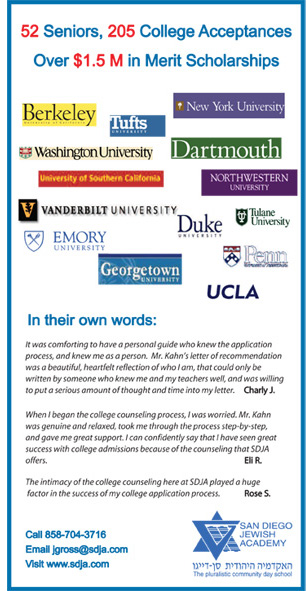


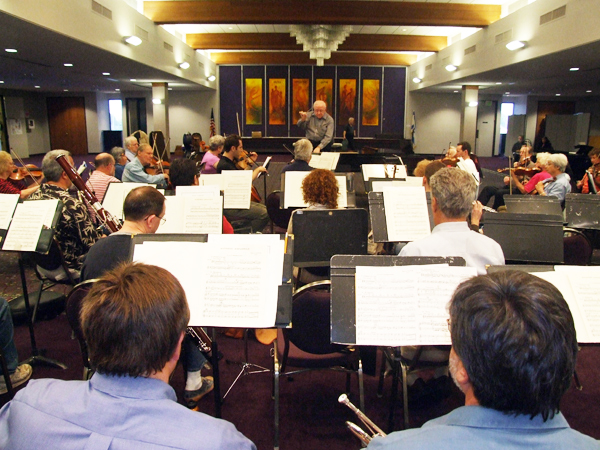
THE JEWISH CITIZEN
XLNC-1, TICO helping to re-popularize
and internationalize classical music
By Donald H. Harrison
 CHULA VISTA, California—When Tifereth Israel Community Orchestra conductor David Amos settled behind the microphone at XLNC-1 Radio to urge listeners to become supporting members of the binational, non-profit, classical musical station, he could speak from personal experience about how music can bring people of Mexico and the United States together. CHULA VISTA, California—When Tifereth Israel Community Orchestra conductor David Amos settled behind the microphone at XLNC-1 Radio to urge listeners to become supporting members of the binational, non-profit, classical musical station, he could speak from personal experience about how music can bring people of Mexico and the United States together.
His parents had traveled from British Mandatory Palestine to Mexico City in the 1930s so his father, Eliezer, could serve as an emissary for the Jewish National Fund among the Jewish community there. David and his sister Dorith subsequently were born in Mexico City, where they learned to play the piano and the flute respectively. Later the family moved to Tijuana, where David’s father became a distributor of curios from the interior of Mexico to the shops that catered to the cross-border American tourist trade.
David continued practicing piano as his family prepared to settle across the border in the United States. Even before the migration, David was permitted to attend Mar Vista High School in Imperial Beach, to which he commuted by car each weekday from Tijuana. Imperial Beach is in view of the studios of radio station XLNC-1, which sits above the salt ponds on the southeastern shore of San Diego Bay.
“Piano is a solitary experience—you practice alone at home, and then you are thrown to the wolves in front of audiences to show how good you are, and that was never my cup of tea,” Amos reflected during a recent interview. “I cannot say enough what a good thing it was for me socially to become part of the concert and marching band at Mar Vista High School… I could hardly speak English at the time, and I played bassoon in the band and bell-lyra (glockenspiel) in the marching band.
“I suddenly became acquainted with what was going to change my life: the communal idea of making music together.”
One of the first American friends Amos made at Mar Vista was an older bass trombone player, Dennis Foster, who subsequently would enjoy a career as a junior high school band and orchestra teacher. Foster preceded Amos to San Diego State University and urged him to major in music there. Following Foster’s advice set Amos on his career—and also resulted in his meeting violinist Lee “Bunny” Feurzeig at a Hillel party at the San Diego State campus. Alerted by mutual friends that they both were interested in classical music, they dated for four years before marrying in July 1966. She went on to serve as a violinist in the San Diego Symphony Orchestra, and he taught music and directed the bands at Madison High School and later at Patrick Henry High School. Along the way, he also obtained a master’s degree from San Diego State.
The two musicians went to concerts together, and played recitals together, but they celebrated their greatest collaborations in 1968 and 1971, respectively the birth years of Ilana, today a Los Angeles pediatrician, and Adina, today an improvisational comic based in Seattle. Like her mother, Ilana plays violin, performing even today in the Doctors Orchestra in Los Angeles.
The year Adina was born David took a sabbatical from San Diego City Schools to study conducting at Indiana University under Tibor Kozma, a master teacher and pianist who had also served as assistant conductor of the Metropolitan Opera in New York City. Amos was called back to the family business in Tijuana before he could complete the doctorate, but while he was still in Indiana, memories—and the kind of music stories that conductors like to tell on the air during membership drives—began to pile up.
According to Bunny, one afternoon when she answered a phone at home, the person on the other end was in a panic. One of the orchestras (Indiana University, which boasted a conservatory, had many orchestras) was scheduled to perform the following night, and an out-of-town conductor had canceled his appearance. David was not at home; he was visiting the Football Hall of Fame in Canton, Ohio.
“I explained that he was out of town but that I expected him within a few hours that day,” Bunny recalled. “I asked what was on the program, and they told me, and I said, ‘well, he can do that; I am sure that is no problem’ and I accepted for him; I said ‘he’ll do it.’ And they said, ‘are you sure you can speak for him? ‘ I said, ‘.. he will conduct the concert for you…’ There were many people they could have asked but they were worried about having someone who could do it without any preparation…”
Amos, laughing, said it was Johann Sebastian Bach’s Concerto for Three Keyboards and Orchestra, and “I had never heard it before.” “But,” Bunny quickly interjected, “I knew it wouldn’t be a problem for him.” So, according to Amos, “I went directly to the organizer’s home that very night; I didn’t even take my coat off.. it was the home of Sidney Foster, a legendary teacher and pedagogue, and he handed me the score to the piece, and I had to lead a rehearsal that evening and the concert was the next day.”
Notwithstanding his relative unfamiliarity with the work, the concert went off “very well,” Amos recalled. “Conductors need to operate with an extreme dose of confidence because if you don’t show confidence at the podium, musicians are very perceptive and their performance will certainly suffer.”
*
 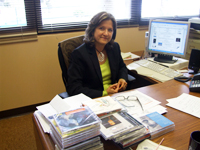 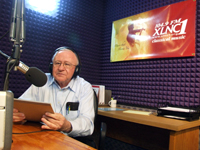
Lisette Atala, station manager of XLNC-1, was classically trained as a pianist at the conservatory in Mexico City, and was working as the cultural attaché at the Mexican Consulate in San Diego, when she met the late Victor Diaz, the station’s founder and scion of a family that decades before had been persuaded by aerospace pioneer Howard Hughes to purchase a chain of radio stations in Mexico.
Atala said that, according to a story that Victor was fond of telling, when he and his brother were young teenagers, their father sent them to New York City to study the format of the classical music station WQXR. “They stayed at the hotel and they started to listen to WQXR and he started to take notes of what they were doing at WQXR, and then he talked to them, and acquired a program schedule of classical music, and started to look, and that is how he learned. He was self taught! Together with his brother, he remembers being at a hotel, listening day and night to WQXR… Then he went to his father in Mexico, and said, ‘I got it!’ and they started a classical station in Mexico, and it was a tremendous success.”
As Atala recalls it, she met Diaz approximately in 1993, when the Mexican Consulate hosted a reception at its offices on India Street. Diaz, whose family already broadcast Radio Latina and Z-90 from Mexico, with studios in Chula Vista, was excited to learn that Atala shared his passion for classical music. He confided in her that he wanted to start a classical station, and asked her to help him. She responded that whereas she knew much about classical music, she knew nothing about radio stations. “Be ready,” he told her. Over the next five years, he called her every six months or so to say that his application for a frequency was still pending with the Mexican government. “Be ready,” he’d keep repeating.
“And then one time he called me and said, ‘Okay, we need to go and buy CDs; we need to get CDs, so I said ‘okay, I have a few if you want to use them…’ and he said, ‘no, no, let’s go…” We met at Tower Records in the Sports Arena area that day, and we were like two kids in a candy shop. I think we spent about three hours there, non-stop, just picking up CDs and putting them in a bag. It was kind of crazy—the employees at Tower could not believe it. I remember he paid more than $3,000. ‘Ah look at this!’ ‘Yeah! Look at that!’ and then we had to go to a special room for them to add up the bill. I will never forget the experience—fantastic. That is how XLNC started” in 1998.
They transported their CDs to the offices of Radio Latina and gradually recorded them all onto a computer program. ‘I went in the evenings, with a technician there with me, and I would tell him, put this one on…’ Victor wanted just the most famous music, what he called ‘the top 400 hits of the last 400 years.’ He said we have to have only the well-known, easy-to-listen to classical music. We had an argument there because I am a classical music-trained person, and I was very orthodox when I met him. I wanted complete works. And, I am a (Gustav) Mahler lover, and with Mahler there is only one thing that you can play that is acceptable for listeners, you have to go to his First. And I am an opera lover, and he said, ‘no opera,’ and I said, ‘you know, I think we have to have all.’ He said, ‘no, no, it just has to be the nicest things.’ That was our first difference, but I kind of followed his advice, even though I felt I was betraying my background as a musician.”
The station made its appearance, not on the air, but streaming on the internet. And it caught on, not just in San Diego but around the world. “We started getting hundreds of emails from people saying ‘this is fantastic, wonderful, what a wonderful station’ so there was acceptance of this idea of Victor, of just having music, and if you wanted to know about the music, you went on the internet to see the title. There were no announcers.” One of her favorite emails came from scientists in Antarctica, who had picked up the music on the Internet. “You are warming us,” they wrote.
* *
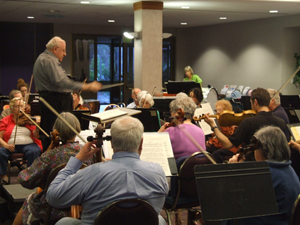 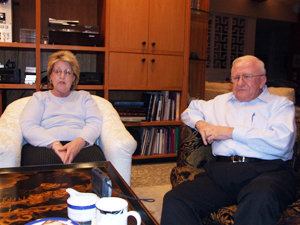
Although Amos had returned from Indiana to work with his father in his business—which had been transformed from one supplying curios to one distributing French perfumes to Mexico’s duty free shops (Amos’ father spoke French and had good connections in that industry) –through the decades he remained true to music, especially after San Diego violinist Eileen Wingard persuaded him in 1974 to become the conductor of a start-up orchestra at the Jewish Community Center, then located on 54th Street.
Growing from a chamber group to an orchestra, its members were both Jews and Gentiles alike, and over the years the East County JCC Symphony began to develop a special niche in San Diego’s music world. According to Amos, it became a group where soloists liked to tune up, to practice, to ready themselves for performances with bigger, more professional orchestras. They practiced by playing with Amos and his orchestra of amateur musicians, semi-professional musicians and retired professional musicians.
A big break for Amos came in 1978 when he received a letter from a member of the Israel Philharmonic Orchestra—on the philharmonic’s own letterhead. The writer introduced himself as Meir Rimon, the principal French Horn, and to Amos’ amazement, he said that he would like to visit San Diego in order to play with the JCC Symphony.
The orchestra was only four years old, but the fact that it was a Jewish-sponsored orchestra was one of the reasons that Rimon was intrigued. “One of the things that he wanted to do was the Ricard Strauss French Horn Concerto, but Strauss had lived in Nazi Germany and was one of Hitler’s favorites,” Amos recalled.
Israelis for many years would not play the music of Richard Wagner, because of his virulent anti-Semitism, and many people in Israel felt similarly about Ricard Strauss, although a full ban on his music never was implemented, according to Amos.
So Rimon came and played the concerto with the JCC Orchestra here, and he and Amos became good friends. Rimon returned a few years later for a second concert date, and then, “in 1980, we received a call, and he said “David, I have reserved the Israel Philharmonic for me to solo and for you to conduct a recording, so be here in Israel this coming August.”
Conducting a university orchestra in Indiana, and a volunteer orchestra at the JCC, had been Amos’ experiences, but “he felt my baton technique could stand up in front of any orchestra in the world; he believed in what I did,” Amos said appreciatively.
Amos recorded with Rimon music mostly of the French Horn player’s choosing on that first album, but when they collaborated again, Amos brought some of his own ideas.
In 1984, when Amos was in Israel again to conduct in a collaboration with Rimon, the session was scheduled just after Leonard Bernstein had guest-conducted the orchestra and while Zubin Mehta was beginning to rehearse it for the next concert.
People who watched Amos and Mehta talk with animation in the wings wondered what the two conductors might be discussing. Technique? The interpretation of a certain passage of music? The quality of the orchestra? “Baseball,” answered Amos. “It was the year that the Padres played in the World Series!”
After collaborating with Meir, Amos began getting invitations to work with other soloists, other orchestras, on other kinds of music throughout North America and Europe. He cited an impressive list of countries in which he had conducted, leading in countries such as in the United Kingdom not one but many of their orchestras. Besides the U.K, U.S. and Mexico, countries included Norway, Lithuania, Russia, Poland, the Czech Republic, Slovakia, and the list goes on. Later this year, Amos will be conducting in Canada.
In the mid 1990s, the Jewish Community Center on 54th Street closed its doors, the victim of changing demographics. Many Jews had moved to La Jolla and the North County, and the JCC decided it could serve more people by moving there. The Lawrence Family JCC was built. The old JCC Orchestra did not make the move with the JCC; instead it affiliated with Tifereth Israel Synagogue, becoming known as TICO (Tifereth Israel Community Orchestra). As before, its players are a mixture of Jews and Gentiles.
Having the opportunity to perform with guest artists who are principals with the Los Angeles Philharmonic, or the Israel Philharmonic or the Toronto Symphony is an inducement for the volunteers who try out for TICO. Having Amos for a conductor—according to his wife, a one-time concertmaster with the San Diego State Orchestra— is also an attraction for soloists.
“There is practically a soloist with every concert, and David will stick with that soloist, so that the soloist feels comfortable to express himself or herself,” Bunny said. “Other conductors impose their interpretation, but David doesn’t do that. He allows the soloist to do his interpretation without interference. It is very tricky to accompany a soloist, because a soloist—even the best—can make surprises for the conductor and the orchestra.”
*
Given Amos’ background, it was not at all surprising that he agreed without hesitation to serve on XLNC-1’s advisory board and to volunteer as a guest on-air fundraiser during membership week. With Lisette Atala, the station manager, and Martha Barba de Diaz, Victor's widow and successor as station owner, Amos is with kindred souls—people who share what he describes as his “Mexican reverence” for classical music. They also believe that classical music must do new things, and reach out in many ways, if it is to be living music, rather than “museum music.” During a recent interview, Both he and Atala expressed concern that without the infusion of new ideas, new modes, new ways of communicating, classical music will keep losing more and more audience.
The ideas of Amos and Atala are different because their institutions and pathways are different—Atala manages a station, while Amos runs an orchestra. But their enthusiasm is similar, and sitting with Amos in Atala’s office recently, I could sense the way these two creative music lovers intellectually nourish each other.
XLNC-1 still streams on the Internet, but now it also is on a radio. It started on 90.7 FM, where it made some changes from Diaz’s format, including the broadcasting of operas and running some music that might not have made it to the top 400. Earlier this year, it switched frequencies to 104.9 FM. Today, there are announcers, who give the name of a work in Spanish before it is broadcast, and in English when it is concluded. The station picks up performing arts broadcasts from other cities, participates in ticket giveaways to the San Diego Symphony, the San Diego Opera, La Jolla Chamber Music Society, Mainly Mozart and other important music presentations in San Diego and Tijuana, and is generally an all-around booster of what Atala calls “excellent music,” eschewing the “classical” label as possibly off-putting.
The change in frequency has resulted in a change of listenership; the stations broadcasts now can be heard along a longer stretch of San Diego County and Baja California coastline, but can’t be heard as well in the East County because of the mountainous terrain.
True of most creative people, Atala has more dreams than funds for improvement of the station. “I would like to have a children’s program on the Internet, because most of the children now are Internet savvy,” she said. “I don’t think children turn on the radio, but they do turn on their computers. We need to do it, but such a program takes $150,000. We have been meeting with some people at the San Diego County Office of Education. Perhaps an interactive game, to offer to public and private schools—that is the time we need to push the love of beautiful music.”
Furthermore, she said, “we need a live studio, because our studio is just a production studio. I’d live to get a live studio with a piano, so we could invite a composer or a musician here to do chamber music. I saw another station in Mexico City—they have an auditorium.”
And, she said, the station would like to be able to broadcast performances of the Symphony, and Chamber Orchestras, and the Opera live.
Now, listen to Amos, as he tells of all the things he would like to do, and is doing , not only to spread classical music, but also to popularize its Jewish components.
“I have been a strong champion, and it is reflected in my recordings, of doing music of living composers, and of creating new pieces, many of them of Jewish subjects or Jewish origins,” Amos said. “One of the big things I try to do is bring the music of Israel, Jewish history and religion, and the Holocaust to the concert hall because this is where I feel we can make an impact on audiences: through music, through the art, through the strength and power that music can be. And since most of our orchestra is not Jewish, it serves as a wonderful entry for them into a synagogue, into Jewish music, but at the same time we play all music.”
Amos added that he wants to commission, “from this point in my life on…composers to write music on Jewish subjects and Jewish history and Jewish ceremonies that would come into the mainstream concert hall and be part of the regular concert repertory much like masses and requiems and other wonderful Christian music already are. I do believe that if we make a concerted effort to encourage living composers, Jewish and Gentile both, to compose works on the Bible, on Dreyfus, on the speeches of Abba Eban, we will bring a new dimension to the concert hall, which is dangerously close to becoming a museum and not a living art form. I think this is the main thrust of my life now.”
One of the conversations took place in the offices by the salt ponds of San Diego Bay. But wasn’t that yeast I sensed in the air?
{Return to top}


San Diego County Jewish Trivia Sports
Adapted from San Diego Trivia (1989) and San Diego Trivia 2 (1993)
{Editor’s Note: Retired librarian Evelyn Kooperman, a friend to the Jewish community, enjoys playing the cello and collecting trivia about her native city of San Diego. This column excerpts Jewish communal items from her two books, San Diego Trivia (1989) and San Diego Trivia 2 (1993). Readers should note that the information has not been updated since the books were published. Kooperman still has a limited supply of the two books, which cover the general San Diego community in all its aspects. Either of the two volumes sells for $5 and may be obtained by telephoning the author at (619) 461-6095.}
By Evelyn Kooperman
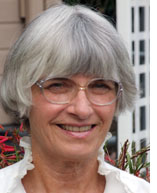 Q1. What was the nickname of Abraham Hollandersky, who traveled with the U.S. Navy and fought over 1000 boxing matches? Q1. What was the nickname of Abraham Hollandersky, who traveled with the U.S. Navy and fought over 1000 boxing matches?
Hints: At the age of six, young Abe had to start supporting his family by selling newspapers. Teddy Roosevelt gave him permission to sell papers to the Navy, so he became their official newsboy, a job that he held for many decades. Because of poor eyesight, he could not join the Navy, but he sailed with them all over the world and became their biggest booster. To supplement his income he learned boxing and became a boxing instructor for the Navy. He took on all challangers, and even fught a kangaroo, a bear, and a Japanese judo fighter. Although he was a welterweight, he held the title of Heavyweight Champion of Panama. Through his job he became friends with many high-ranking Naval officers, and he met all the presidents of the United States. After retiring from the ring, he and his wife settled in San Diego, where he remained a popular figure with the Navy until his death in 1966 at the age of 78.
Q2. What San Diegan was voted "Most Popular Sportscaster in America" in 1987?
Hints: He moved to San Diego in 1977 when he was offered the job of television sportscaster at KFBM-TV. He developed quite a following with his opinionated commentary and his radio and television play-by-play broadcasts of the San Diego Aztecs, Clippers, Chargers, and Padres. In a 1987 national survey he was voted the country's best sportscaster, and he has won the Southern California Golden Mike award for sports commentary three times. Fans can read his caustic wit in his 1985 book of sports anecdotes.
Click here for answers
{Return to top}

ADVENTURES IN SAN DIEGO JEWISH HISTORY
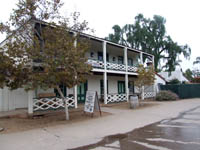
Robinson-Rose House
|
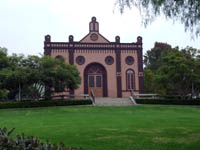
Old Temple Beth Israel |
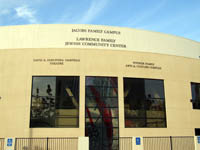
Lawrence Family JCC |
Editor's Note: We are reprinting news articles that the Southwestern Jewish Press ran in 1950. If you have historical topics about the San Diego Jewish community you would like us to explore, please e-mail your suggestions to editor Don Harrison at sdheritage@cox.net
Beth Jacob Sisterhood
From Southwestern Jewish Press, July 21, 1950, page 6
The newest affiliate of Congregation Beth Jacob, the Beth Jacob Sisterhood, recently held a luncheon meeting at which time nomination and election of officers took place. Mrs. Julius Penn opened her charming spacious home in Point Loma for the luncheon and meeting.
Elected to guide the destinies of this new organization in the initial year are Mrs. Morton Thaler, president; Mrs. Jack Prager, 2st vice president; Mrs. Morris S. Kraus, 2nd vice president; Mrs. Aubrey Shulkind, 3rd vice president; MRs. Wm. Penn, recording secretary; Mrs. Seymour Saltzman, corresponding secretary, and Mrs. Julius Penn, financial secretary. Treasurer will be Mrs. Robert Strauss and Mrs. Zel Camiel will be parliamentarian.
Five trustees were also elected. They are Medames George Borushek, Nathan Feinberg, Yale Kahn, Morton Peskin and Dave Schwartz.
The North Park Lions Club at 3927 Utah Street will be the scene of the installation of these officers on Thursday evening, August 17th at 8:00 p.m. A novel form of installation is being planned by chairmen for the event, Mrs. Zel Camiel who will have Mrs. Mack Freedman as her co-chairman.
Mr. Harold Keen, well known San Diego writer and radio commentator, will be the installing officer. The theme of the installation will be a nautical one, with novel entertainment to follow. Refreshments will be served at the close of the installation.
A working committee for this affair will be announced in the very near future and invitations will be issued to everyone to attend the launching of the “top brass” for the first time of the Beth Jacob Sisterhood.
Council Inaugurates New Program
From Southwestern Jewish Press, July 21, 1950, page 7
Mrs. David Doctor, Pres. Of the local chapter of the Nat’l Council of Jewish Women, announced that on Tuesday, July 11th, an orientation group for the Emigrees was started, under the leadership of Mrs. Philip Rand. Mrs. Rand explained the purpose of these Tuesday evening sessions to the Group.
Rose Anderson, Secretary of the Jewish Welfare Society, spoke on the importance of Emigrees learning English. She stated that the newcomers two main problems are English difficulty and securing a position. In her opinion, mastering the English language is of major importance. She stressed that the Emigrees make every effort to learn English since it is the key to finding a position.
Mrs. Harris Rubel, the over-all Chairman of Service to Foreign Born, for the Council of Jewish Women, was on hand with delicious cookies “a la Lucille Rubel,” which were served with tea. It was an interesting evening for all.
The Orientation Group is in need of teachers. If you wish to devote a few hours of service to our New Americans please contact Rose Anderson at F-1803.
S.D. Guarantees Care for 27 More D.P. Families
From Southwestern Jewish Press, July 21, 1950, page 8
In an emergency meeting of the Board of Directors of the United Jewish Fund, called to hear the report of the Executive Committee, the Board of Directors of the United Jewish Fund acted favorably on recommendation to take an additional 27 D.P. families in 1951.
San Diego will guarantee jobs and housing for 27 Jewish displaced families in addition to the 36 Community Assurances already given for this year, Victor Schulman, Pres., announced. This means that some 90 additional Jewish displaced persons will be able to resettle in this area under the liberalized DP Act recently passed. 35 families already have been resettled her since the first of the year.
The additional community assurances were recommended by the Émigré Committee of the United Jewish Fund, and the Executive Committee of the Fund in response to a request from national officials of the United Service for New Americans that every additional displaced person allowed under the new Act be brought into this country.
Some 65 families, representing about 200 individuals, already are in San Diego on community and corporate assurances basis, according to Albert A. Hutler, Executive Director of the United Jewish Fund.
In addition Hutler estimated that the same number have resettled here on the basis of individual assurance, of which the committee has no record.
San Diego Jewish Trivia Answers: 1) "Abe the Newsboy"; 2) Ted Leitner
{Return to top}


SAN DIEGO JEWISH WORLD THE WEEK IN REVIEW
Judy Lash Balint in Jerusalem: Pollard, Jewish identity and the drosh — subjects on a Jerusalem evening stroll
Donald H. Harrison is San Diego: Leftover matzah is no cocktail cracker
Sheila Orysiek in San Diego: City Ballet tilts and wins with Don Quixote
Fred Reiss in Winchester, California: Book examines biblical interpretations
Adventures in San Diego Jewish History: What was the Jewish community news in 1950? Who were the newsmakers? Our archives answer these questions in daily installments
Shoshana Bryen in Washington DC: Europe is fatigued by moral issues like the Holocaust, Israel's existence
Donald H. Harrison in San Diego: Chabad Jewish Center, St. Therese Catholic Church share history, but not theology
Sheila Orysiek in San Diego: A 'New Look' is something I don’t need
Gary Rotto in San Diego: Here's how consumers can help eliminate Americans' dependence on foreign oil
Eileen Wingard in San Diego: Felder portrays Beethoven the man and Beethoven the musician at Old Globe
Adventures in San Diego Jewish History: What was the Jewish community news in 1950? Who were the newsmakers? Our archives answer these questions in daily installments
Shoshana Bryen in Washington DC: Naqba, or catastrophe, is propaganda; truth is Palestinians' self-imposed victimhood
Ulla Hadar in Kibbutz Ruhama, Israel: Mortar kills Kfar Aza man in his garden
Donald H. Harrison in San Diego: Jewish-named places in San Diego's news
Rabbi Baruch Lederman in San Diego: The Rosh Yehsiva's love for his talmadim
Sigal Shalev Peres in Hazeva, Israel: A Yom Ha'atzma'ut party to remember
Rabbi Leonard Rosenthal in San Diego: Some guidelines for synagogue dress
Ira Sharkansky in Jerusalem: Olmert inquiry focuses on dealings with American fundraiser Moshe Talansky
Adventures in San Diego Jewish History: What was the Jewish community news in 1950? Who were the newsmakers? Our archives answer these questions in daily installments
Shoshana Bryen in Washington DC: Israel at 60 continues to bend over backwards to accommodate neighbors
Cynthia Citron in Hollywood: Credit Sweetest Swing in Baseball with RBI
Ulla Hadar in Kibbutz Ruhama, Israel: Austria's president tells Israeli delegation of his sympathy for Sha'ar Hanegev residents
Donald H. Harrison in San Diego: Hebrew Day takes virtual tour of Israel
Sheila Orysiek in San Diego: Chapter Seven in the serialization of her novel, Reluctant Martyr
Adventures in San Diego Jewish History: What was the Jewish community news in 1950? Who were the newsmakers? Our archives answer these questions in daily installments
Shoshana Bryen in Washington, D.C.: King Abdullah points out Rice's folly
Donald H. Harrison in San Diego: SDJA students, faculty join worldwide quest to be largest group singing at the same time
Rabbi Dow Marmur in Toronto, Canada: Oh, Canada: Do you honestly think that Jerusalem is not a real part of Israel?
Sheila Orysiek in San Diego: The day that Israel became a nation
Cheryl Rattner-Price in La Jolla, California: JCC features work of 8 women artists
Hal Wingard in San Diego: His song, "Noah"
San Diego Jewish World staff in San Diego: Jay Winheld, CPA and Jewish volunteer, dies at 71.
Adventures in San Diego Jewish History: What was the Jewish community news in 1950? Who were the newsmakers? Our archives answer these questions in daily installments
< BACK TO TOP
|
|
